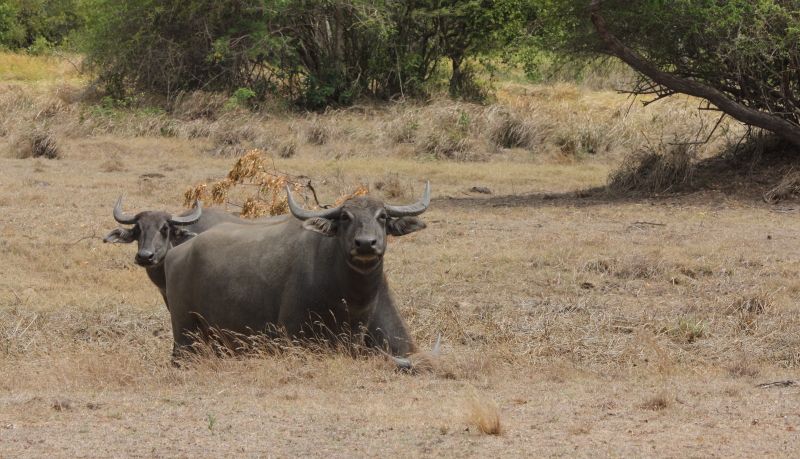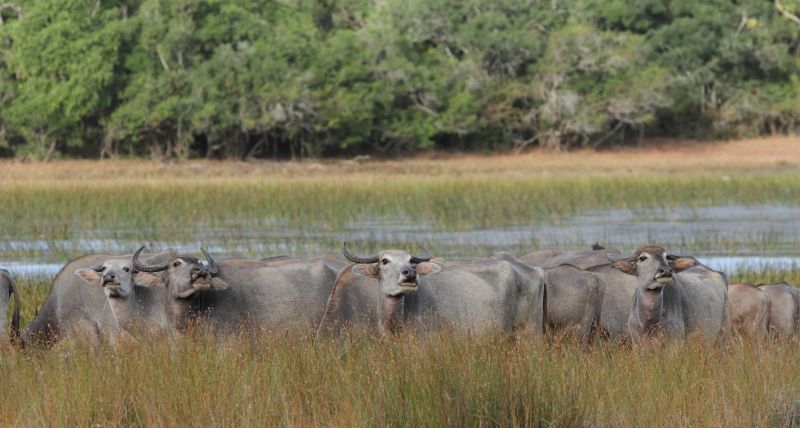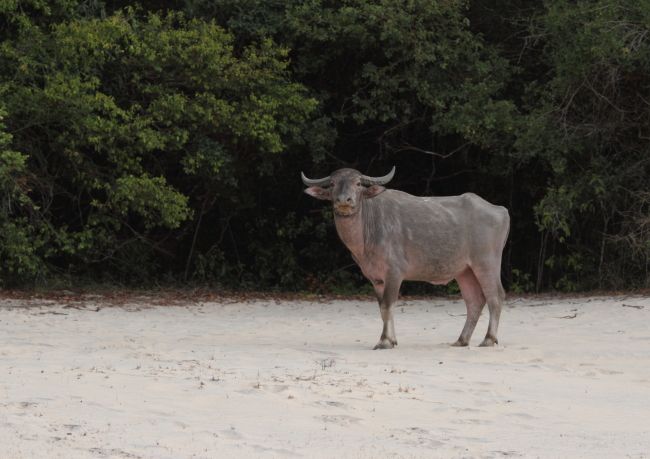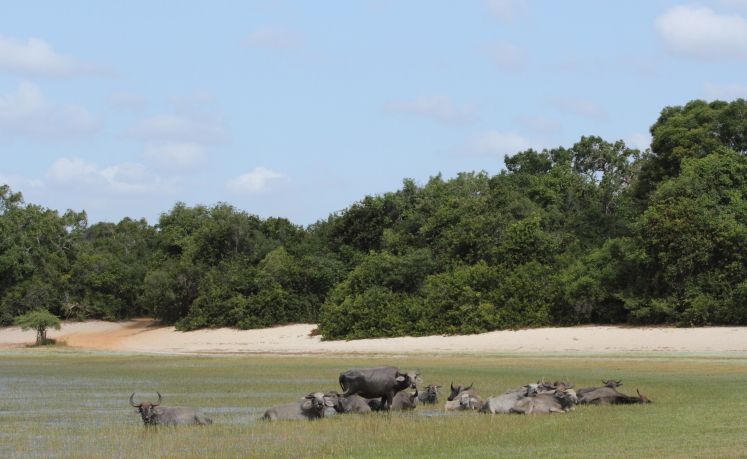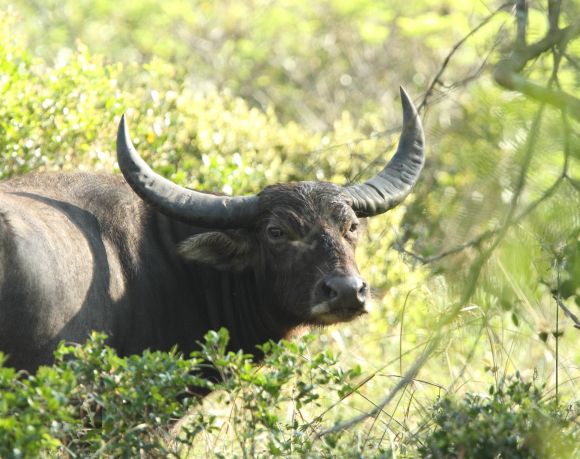
Mammals ‹‹ Go Back
There are four subspecies recognized in the world. B.a. arnee in Eastern Peninsular India and South Nepal, B.a. fulvus in North-Eastern India and Northern Myanmar, B. a. migona in Southern Sri Lanka and B.a. theerapati in Western Thailand and Cambodia. Even though there has been much debate over the existence of the Sri Lankan subspecies due to interbreeding with domestic populations, research conducted by C. P. Groves and J. Jayewardene in 2009 suggests that the pure-bread form of the Asian Wild Buffalo still persists in Yala National Park.
The conservation status of this species is regarded as Vulnerable (National Red list 2012) and it is a species protected under the Fauna and Flora Protection Ordinance as amended by Act No. 22 of 2009.
I have observed Wild buffalos in most of the dry zone national parks such as Yala, Kumana, Bundala, Maduruoya, Galoya, Bundala, Wasgomuwa, and Udawalawa. I have seen it in the hills only at Pitawala Pathana’ and Meemure’ at an altitude of 1300 meters in the Knuckles forest reserve. However I’m not able to conclude whether these are animals resident in the Knuckles forest reserve, semi domesticated or whether they move up during the dry season from the Wasgomuwa National Park through contagious forests such as the Eluwanakanda forest’ as in the case of elephants.
The Wild Buffalo is truly a dangerous and unpredictable animal that should be avoided if you happen to be on foot. Once at Kumana National Park, while conducting the annual waterfowl survey for the Ceylon Bird Club I walked to the edge of a water body carrying my filed scope, accompanied by a guide from the Department of Wildlife Conservation to take a count of the waterfowl. While I was observing the waterfowl a herd of Wild Buffalo came to water and one of them, after looking at us with its head raised for a few minutes, suddenly charged. We had to make a quick get away and return later to retrieve my field equipment which was fortunately not damaged.
Despite the results of the aforementioned research by Grove & Jayewardene, there is much debate over the existence of the true wild species in the country today due to an out break of a decease referred to as rinderpest’ at the end of the 19th century which resulted in the near elimination of this species and due to the small population that may have survived interbreeding with the domestic populations. In this regard I wish to reproduce a paragraph that I have read from the Encyclopedia of life for the benefit of the reader.
The origin and current genetic status of the herds of apparently wild buffaloes in Sri Lanka is uncertain but it is thought unlikely that any true wild buffaloes remain there today. Corbet and Hill (1992) included Sri Lanka within the historical range of wild buffalo, although Ellerman and Morrison-Scott (1951), Gee (1964), and Maia (1970) thought that the Sri Lankan buffaloes were descended from introduced domestic stock. Certain ancient texts seem to support this view (Ashby and Santiapillai 1983). The fact that no buffaloes occur south of the Godavari River in India has also been taken to suggest that Sri Lanka possesses only feral buffaloes descended from introduced animals. However, Deraniyagala (1953), considered that the occurrence of fossil buffalo teeth in the gem sands of the Ratnapura area disproved this view, although it is not clear how old these buffalo teeth are (and Gaur remains found at similar depths in the same area were less than 1,000 years old). Moreover, morphometrics suggest that there was an ancestral population of animals on that island closer to Wild Water Buffalo than to Domestic Water Buffalo (Groves and Jayantha Jayawardene unpublished). Nevertheless, even if the Water Buffalo is indigenous to Sri Lanka the question of whether the free-living herds found there today should be treated as wild B. arnee still arises. In the nineteenth-century, free-ranging herds were common over much of the islans dry low country but they were nearly eliminated by an outbreak of rinderpest at the end of the century, and for a time their survival was in doubt (Phillips 1935). Phillips reported that small populations might have survived in the hill country but the subsequent intensification of agriculture probably led to their demise (Ashby and Santiapillai 1983). After the rinderpest outbreak buffalo recolonized much of the dry zone but most of them had apparently interbred with domestic stock and in 1953 Deraniyagala wrote [the] relatively purest herds are restricted to Yala Game Sanctuary, but much vigilance will be necessary if this remnant is to be kept free from domestic animals which are now encroaching upon this once inaccessible area’. Woodford (1979) also suggested that the genetic integrity of the wild form has already been lost in Ruhuna. To conclude, even if it is assumed that Wild Water Buffalo once occurred on Sri Lanka it seems unlikely that they survived the rinderpest outbreak and the subsequent genetic swamping by feral and domestic buffalo: consequently all free-living buffalo populations on Sri Lanka almost certainly contain genetic input from domestic or feral stock.
Despite the uncertainty of its species and the origin, as with most dry zone National Parks, Buffalo in truly wild state are found at Wilpattu as well. While I have seen small herds between 10-20 at Borupan Wila, Andaragollawa Tank, Mahapatessa and Kudapatessa and hoof marks on most roads, the highest concentration of this species I have observed in Wilpattu so far has been at Maha Wewa. On 14th July and 2nd September 2012 I counted 67 and 80 Wild Buffalos at this picturesque location.

